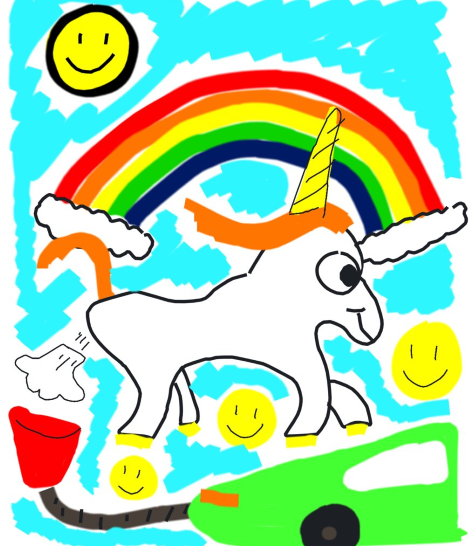
Tesla’s co-founder and CEO Elon Musk, whom many regard as having ingenious ideas that are out of this world, is currently entangled in a copyright situation over an image that is – well, out of this world. Artist Tom Edwards of Denver, Colorado claims that Musk has used one of his original mug designs, which features a car being powered by gas from a unicorn’s behind, without authorization. The reverse side of the mug reads, “Electric cars are good for the environment because electricity comes from magic!”
It all started in February 2017, when Musk tweeted a photo of that very mug, calling it “maybe my favorite mug ever.” A month later, he tweeted, “Made today on Tesla sketch pad” and included a photo of a sketch of the unicorn. Just like the mug, the “sketch pad” illustration sports a rainbow in the background, multiple smiley faces dotting the sky, and a goofily-grinning unicorn emitting a puff of gas into a tube that is connected to a green car. Musk was now using the unicorn image to promote Tesla’s latest “sketch pad” feature. When an image is used commercially, its creator usually has the right to claim compensation.
Edwards did not take action until Tesla used the design again, this time by sending out a digital Christmas card to all Tesla car owners featuring the farting unicorn in December 2017. The farting unicorn also showed up as an app icon on the Tesla console screen. Edwards is now seeking compensation for Tesla’s use of the unicorn image. In May 2018, Edwards sent a letter to the company asking for compensation. However, there was no initial response. When confronted by Edwards’ daughter via Twitter, Musk brazenly tweeted back, “We gained no financial benefit. Have asked my team to use a diff example going forward. He can sue for money if he wants, but that’s kinda lame. If anything, this attention increased his mug sales.” Many Twitter users were quick to jump in on the conversation. According to The Denver Post, due to all the pressure from media attention, Tesla has finally responded to the letter, and now Edwards’ and Tesla’s lawyers are working out a settlement. Edwards has said that he is fine with Musk using the art so long as he is compensated.
Edwards may not realize how lucky he is that settlement is a real possibility for him. While it is true that under the Copyright Act of 1976, the act of producing an original work imbues it with copyright, statute 17 U.S.C. § 412 presents a distinction in the damages an artist is eligible to receive depending on when the work was registered with the U.S. Copyright Office. Specifically, an artist cannot receive statutory damages or attorney’s fees for any infringement of copyright that occurred before the effective date of the work’s registration. In this case, Edwards did not register his image with the U.S. Copyright Office until after the misuse commenced, so it would have been a financial risk for him to dive into the litigation process. Even if he eventually prevailed in his claims against the mighty Tesla, an extensive lawsuit could mean that any damages he obtained would get swallowed up by the attorney’s fees he would be individually responsible for.
Had this issue not received the attention it did through social media, Musk likely would not have relented, and Edwards would have probably decided to drop the issue instead of expending substantial resources for the sake of litigation. Tesla may not have enjoyed any direct financial benefit, but by using a blatant copy of an artist’s work for a promotional campaign, the company engaged in a clear copyright infringement. Whatever people’s opinions are on the unicorn mug itself, Edwards deserved compensation beyond simply being able to sell a few more mugs, especially when the corporation who misused the image reported $3.3 billion in revenue in 2017, and thus is in a position to offer Edwards some form of payment. Social media may have been the sling and the stone in this situation if we are to employ Edwards’ “David and Goliath” analogy that he has referenced in interviews, and if a hefty settlement does emerge in this situation, it could be a way for artists to topple the “Goliath” corporations who take advantage of them. In fact, Edwards has said he wanted to speak out partially because of similar stories he often heard from fellow artists. “I realize my farting unicorn is not as serious as whistleblowers,” he said, “but honestly, it’s all about integrity.” He added: “I’d really like to get on Elon Musk’s good side…he’s really, really interesting. But he isn’t above copyright law.”
Artists like Edwards can greatly benefit from registering their original works as soon as possible so that their legal positions are strengthened if copyright infringement ever does occur. Under 17 U.S.C. §§ 412, 504, and 505, if a copyright is registered within three months of publication or prior to the commencement of an infringement, the copyright owner can pursue statutory damages and attorney’s fees. Since it is difficult in practice to prove that actual damages have been incurred or that the infringer has enjoyed substantial profits through infringement, seeking statutory damages and attorneys’ fees may be the best method for the artist to receive any compensation. Furthermore, according to 17 U.S.C. § 410(c), a copyright registration constitutes prima facie evidence of a copyright’s validity. An artist with a copyright has the exclusive right to reproduce, copy, or change the work, and the copyright notifies the world that the artist owns the work along with all the rights of ownership. Thus, artists should not hesitate to begin the process of registering their original works with the U.S. Copyright Office.
If you're an artist looking to navigate the shores of the U.S. Copyright Office, please don’t hesitate to contact us.